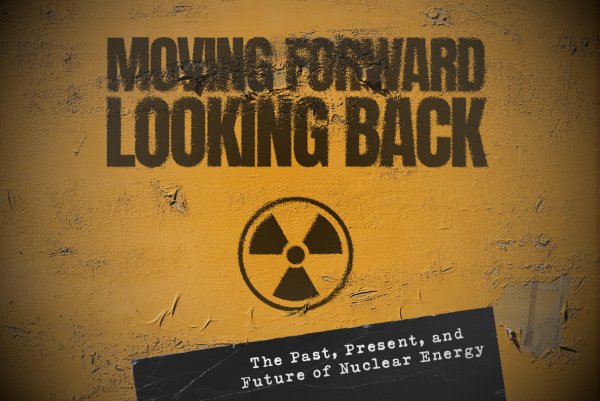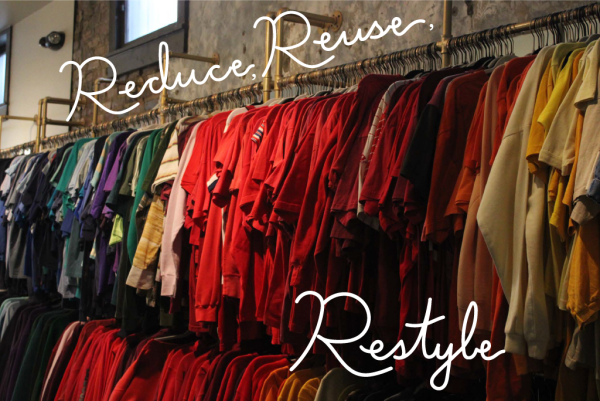YOU ARE WHAT YOU TWEET- Is Trump’s usage of Twitter presidential?
A ding echoes through the room. The back pocket of someone’s jeans vibrates. A screen flashes on from the corner of someone’s office desk. Millions of heads turn to look at the Twitter notifications on their lock screens. Someone immediately favorites and retweets an announcement of a transgender military ban.
Someone else just rolls their eyes in response to a statement that the “FAKE NEWS media” doesn’t work to inform the Americanpeople, but rather to mislead them. A student lets their phone slip from their grasp in the realization that they are no longer protected under DACA, Deferred Action for Childhood Arrivals. President Donald Trump is online.
Trump currently has over 44.1 million followers on his Twitter account, @realDonaldTrump. In addition, the presidential account, @POTUS, has 21.4 million followers. With @POTUS serving mainly to retweet @realDonaldTrump, Trump’s tweets are certainly reaching far and wide.
In April of 2016, Trump told CBS’s “60 Minutes” that if he used Twitter as president he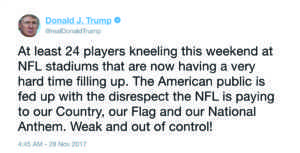 was “going to be very restrained. If I use it at all, I’m going to be very restrained.” With Trump tweeting an average of 11 times every day, we are left to wonder what Trump means by “restrained.” Not only is the restraint of Twitter use seemingly no longer one of Trump’s goals, but Twitter has become his main platform.
was “going to be very restrained. If I use it at all, I’m going to be very restrained.” With Trump tweeting an average of 11 times every day, we are left to wonder what Trump means by “restrained.” Not only is the restraint of Twitter use seemingly no longer one of Trump’s goals, but Twitter has become his main platform.
#nofilter
Trump ranks in the ninetieth percentile for the amount of followers and tweets on his account according to Twitter Counter, a website that provides statistics for each Twitter user. Instant communication to the world with the convenience of a few taps on a phone or computer screen may explain his reliance on Twitter.
In fact, this past October in Independent, an online, international news source, Trump said regarding social media, “When somebody says something about me, I am able to go bing, bing, bing and I take care of it. The other way, I would never get the word out.”
With 47 percent of teens using Twitter according to a University of Chicago study of teen social media usage, we see just how quickly Trump can connect with a younger audience. Twitter allows easy communication between users and enables them to tag other users. This makes it even easier for Trump to call out people by name on Twitter and attack “fake news,” like we’ve seen him do in the past. What that says about Trump is up to you.
Trump often refers to news outlets that verify the news—think the Washington Post, the New York Times, and CNN—as “fake news.” In an interview with Mike Huckabee on the Trinity Broadcasting network, Trump said, “The media is really, the word, one of the greatest of all terms I’ve come up with, is ‘fake.’”
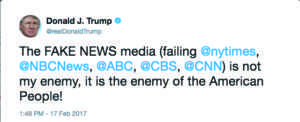
It is unclear whether Trump is saying he created the word “fake” or was the first to use the phrase “fake news,” but both statements are false. According to Merriam-Webster, “fake news” was first used in the nineteenth century by newspapers and recently, “fake news” was added to online dictionaries and the Associated Press (AP) Stylebook, a book that gives guidelines to writers for journalistic style. The definition of “fake news” that the AP Stylebook provides refers to actual false information. However, Trump calls entire organizations “fake news” when he doesn’t like what they report.
The AP Stylebook reads, “The term fake news may be used in quotes or as shorthand for the modern phenomenon of deliberate falsehoods or fiction masked as news circulating on the internet.”
CNN’s chief national correspondent, John King, is one of many individuals who Trump has called out on Twitter. Trump called him “underachieving” and referred to the TV show he anchors, “Inside Politics,” as “one hour of lies.” King says that Twitter is part of Trump’s political strategy, so it’s here to stay.
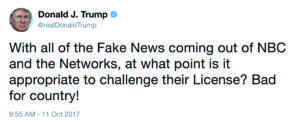
“I think we have seen that his Twitter feed is pure Trump. That’s what he’s thinking. Whether you like it or not, it’s transparent. We know a lot more about our president because he uses it,” King told On the Record.
In other words, even though Trump’s account is partially managed by his staff, King and others know that when it comes to disrespectful or unrevised tweets, Trump himself is the mastermind behind the statements.
With frequent errors, it’s no secret that Trump has encountered some issues with the spelling and grammar of his tweets. The more commonly known errors are “heeling” instead of “healing” when Trump referenced the victims of Hurricane Harvey and “covfefe,” an error that he never did completely clarify. Active teenage Twitter users in particular might notice the mistakes in his tweets, just as these students have learned to notice grammar and spelling errors in writing. Among the youth in Louisville, some, like 16-year-old Ballard junior Trinity Olmstead, think casual tweeting from the President of the United States is unacceptable; others think it just proves that Trump, like all of us, is human.
“Sometimes he comes up with something in his mind and just tweets it,”Olmstead said. “It’s sometimes a mistake but that shows that he’s not actually thinking about what he’s saying. He’s just doing a free for all and saying whatever he wants to say and just thinking that people are gonna like it.”
Olmstead’s opinion is popular because it’s an easy conclusion to jump to, but others like Aiden Martin don’t see Trump’s Twitter usage as much of a problem.
Martin, a 16-year-old junior at Atherton High School, said, “I only check Twitter for a couple seconds a day, just scrolling down, but I read some of his stuff. It seems totally normal for a president tweeting. It’s just the once-in-a-blue moon tweets that get reported on the news. I think he seems more human than presidential on Twitter.”
So, are the content and tone of Trump’s tweets unpresidential, or is Trump redefining presidential communication? For us, we look at the situation in different ways. One side perceives Twitter as Trump’s way of reaching the youth in an efficient manner, bypassing the media to portray a more direct relationship with the people. This group thinks that presidential tweeting is okay. On the other end of the spectrum, Trump is perceived as no better than a technology-obsessed teenager, constantly tweeting comments and opinions in order to start controversy and disagreements. However, not everyone falls under such extreme opinion. You may lie somewhere in between.
So Where Do We Draw the Line?
As times are changing, we have seen an increase in other professionals and large organizations who use Twitter to communicate with the public in an efficient manner. But when other public figures tweet, there isn’t nearly as much backlash or controversy. So what makes Trump so different? As president, a large amount of the population expects Trump to tweet using proper spelling and grammar and to refrain from directly calling out other Twitter users like Comey and King. In other words, his unorthodox behavior can be confusing, because, well, he’s the president.
“Every Republican told him he couldn’t win the nomination. Every political consultant told him he couldn’t win the presidency. He did. And so, whether you like it or don’t like it, he thinks [Twitter] is a staple of his success,” King said.
Maybe it is a strategy, or maybe it’s just Trump being Trump; either way, we push our phones back to the corner of our desks, the screens now a solid black. Millions of us shove Trump’s latest tweet to the back of our heads and return to our daily lives. Over time—if his words don’t directly affect us—we forget. If they do, we are forced to deal with consequences that could potentially be life-changing. All because of a tweet that took seconds to create. We can continue to ask ourselves why Trump uses Twitter the way he does and what that means for the future, but chances are it isn’t going to change. We may not have the answers right now, but President Trump, we are watching.
Donations are collected through The Publishers, duPont Manual High School's booster club for J&C. On The Record relies completely on sponsorships, advertisements, and donations to produce and distribute each issue. Please consider donating to our cause, and helping the student journalists of OTR amplify youth voices for years to come.



